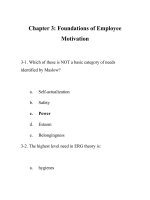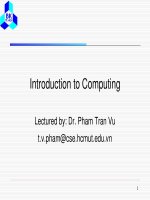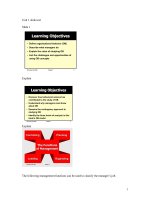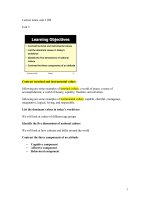Organizational behavior: Lecture 3 - Dr. Mukhtar Ahmed
Bạn đang xem bản rút gọn của tài liệu. Xem và tải ngay bản đầy đủ của tài liệu tại đây (246.8 KB, 42 trang )
Organizational
Behavior
(MGT-502)
Lecture-3
Summary
of
Lecture-2
Basic OB Model
Organization
Organization
systems level
systems level
Group
Group
level
level
Individual
Individual
level
level
What Managers Do?
Gets things done through other
people
Make decisions, allocate
resources, and direct the activities
of others to attain goals
Do their work in an organization
New Managerial Functions
To provide leadership and direction
Total Quality
Continuous
Management
Improvement
Today’s Topics
Organizations: The
Important Component
Where do managers work?
in organizations!
What is an
Organization?
A consciously coordinated social
unit, composed of two or more
people, that functions on a
relatively continuous basis to
achieve a common goal or set of
goals.
What are organizations?
• Social entities
• Goal oriented
• Deliberately structured
• Linked to the external environment
Organization
A systematic arrangement of people to accomplish
some specific purpose.
VU
Steel Mills
Govt. Agencies Glossary Store
Hospitals
United Nations
Components of an Organization
Task - an organization’s mission, purpose, or goal
for existing
People - the human resources of the organization
Structure - the manner in which an organization’s
work is designed at the micro level; how
departments, divisions, & the overall organization
are designed at the macro level
Technology - the intellectual and mechanical
processes used by an organization to transform
inputs into products or services that meet
organizational goals
Formal vs Informal
Organization
Formal Organization - the part of the
organization that has legitimacy and
official recognition
Informal Organization - the unofficial
part of the organization
Basic Systems View of
Organization
Environment
INPUTS
Human,
physical,
financial, and
information
resources
TRANSFORMATION
PROCESS
Feedback
loops
OUTPUTS
Products
and
Services
Organizations as Systems
Task environment:
Competitors
Unions
Regulatory agencies
Clients
Inputs:
Material
Capital
Human
Structure
Task
Technology
People
(Actors)
Organizational Boundary
Outputs:
Products
Services
Why do we have
Organizations?
They are more efficient
than individuals acting
independently
How does an
Organization Create
Value?
Organization’s Inputs
–
–
–
–
Raw material
Capital
HR
Information &
Knowledge
Organization’s
Environment
–
–
–
–
–
–
Customers
Shareholders
Suppliers
Distributors
Competitors
Government
Organization’s
Conversion Process
–
–
–
Machinery
Computers
Human Skills &
Abilities
Organization’s
Outputs
–
–
–
–
Finished Goods
Services
Dividends
Values for
Stakeholders
Why do Organizations Exist?
To increase specialization and
division of labor
Use large-scale technology
Manage the external environment
Economize on transaction costs
Exert power and control
Organizational Stakeholders
Inside
– Shareholders
– Workforce
Outside
– Customers
– Suppliers
– Government
– General Public
Organizational
Effectiveness
Satisfying
Stakeholders Goals
and Interests
How do Managers
Measure Organizational
Effectiveness?
The external resource approach----Control
– Evaluates the ability to secure, manage, and control scare
and valued skills and resources
Low costs of inputs
Obtain high-quality inputs of raw material and employees
Increase market share
The internal system approach----Innovation
– Evaluates the organization’s ability to innovate and function
quickly and responsively
Cut decision making time
Increase rate of product innovation
Increase coordination and motivation of employees
Reduce conflict
Reduce time to market
Technical approach----Efficiency
–
Evaluates the organization’s ability to
convert skills and resources into goods
and services efficiency
Increase product quality
Reduce number of defects
Reduce production costs
Improve customer service
Reduce delivery time to customers









